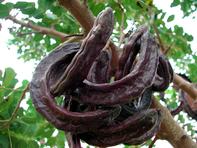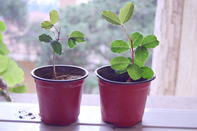The carob tree (Ceratonia siliqua) also known as St John’s Bread is a small to medium evergreen leguminous tree with glossy leathery leaves.

It produces 13 - 30 cm long flat leathery seedpods with a sweet chocolatey pulp and gum, containing bean-like seeds. The carob is not indigenous to South Africa but shows much promise as an animal and human feed to enhance indigenous food supply.
Research on the carob was conducted in the USA in 1949, with the best varieties selected and cloned, some of which were then supplied to South Africa. At least seven clones are used worldwide, ranging in flavour, pod size (flat, curved, twisted or flat), as well as seed and sugar content (from 48% - 56%).
The five available varieties grown in South Africa (mostly Western Cape) were tested in a study by the Department of Food Science of Stellenbosch University in 2010. Sugar levels (of which 70% was sucrose) ranged from 40 - 54%, protein as well as a total of 17 amino acids were detected, including the seven essential amino acids.
Several food products - bread, breakfast cereal, a milk-based drink, porridge and a mousse were developed during this study. Due to little management required, the carob tree is suitable for low-input production systems. Carob trees are popular ornamental plants used for landscaping and windbreaks. It is an effective fire barrier as its leaves burn very poorly.
The wood is hard and close-grained and is prized for its use in carpentry. It burns slowly and is good firewood, making excellent charcoal. The pods and leaves are an excellent animal feed for cattle, pigs, goats, sheep and donkeys. Carob has a range of uses in human food. It can be eaten fresh or roasted.
Ground seeds are used to make locust bean gum (a galactomannan), used as a thickener and to impart a chocolatey flavour to foods. The carob tree has been grown for millennia in most countries around the Mediterranean sea, usually in temperate conditions and often in semi-arid areas with poor soils.
Notable producers of carob include Spain Italy, Morocco, Turkey and Portugal. Portugal, according to UN statistics, produced over 40 000 ton of carob in 2016. Carob powder used in South African products are mostly imported from Spain.
The carob seed was also used as a weight measure for gold and gems because seeds are very even in weight. The word ‘carat’ comes from qīrāṭ the Arabic name of the seeds.
How to Grow Carob Trees

The slow-growing carob tree can be grown from seed. Seeds require boiling water treatment followed by three days of soaking to improve germination. The seeds should be sown in a sandy potting mix (in spring or summer time) in individual containers such as recycled milk cartons. Seedlings are transplanted when 8 - 10 cm high.
Avoid damaging the fragile taproots when transplanting the seedlings. Carob trees are trioecious meaning that both male and female trees exist and some varieties bear both male and female flowers. One male tree can pollinate about 10 - 20 females.
Pollination is carried out by wind and insects, but low yields are often due to poor pollination. Carobs can tolerate drought, sea breezes and any soil type except heavy clay and acidic soils. They enjoy dry, rocky sites.
Carob trees require little irrigation and fertilisation and no pruning. Carob pods are harvested before winter and should be prodded off the tree with a pole, collected in nets or sheeting under the tree and then sun-dried. Pods are produced after 6 - 7 years and up to 125 kg of pods can be harvested from a mature tree (+25 years).
A yield of about 2 kg can be expected from a 6-year-old tree. Improved varieties can bear fruits (pods) within 3 to 4 years. Diseases in carob trees are few and the only pests are scale insects and carob moth, Myelois ceratoniae.
By Marinda Louw